12 Surprising Retail Investor Statistics (USA and Europe) in 2023
The last bull market was filled with them, and they’re now retreating in force. Here are some of the more interesting facts about these curious creatures.

Retail investors were once dismissed as an odd sideshow, but the growth of retail trading is forcing everyone from hedge funds to government agencies to take note. Millions of people worldwide now have trading apps installed on their phones and are buying and selling stocks, currencies, commodities and other assets daily.
The bull run years of 2020 and 2021 helped stoke the fires of retail trading, as people saw their friends and favourite celebrities making money hand over fist. Everyone and their uncle seemed to be a genius trader – until the market crashed in early 2022.
We wanted to bring light to the current situation and some more interesting facts about retail investors, their trading habits and how they impact the markets. So here are 12 retail investors statistics you should know in 2022.
1. How many Americans invest in the stock market?
According to the latest survey by the US Federal Reserve, 53% of American adults reported owning stocks or stock-based investments in 2019. When direct and indirect forms of stock holdings are combined, the FED’s data show a slight uptick in stock ownership since 2016, when 52% of survey respondents said they owned stocks.
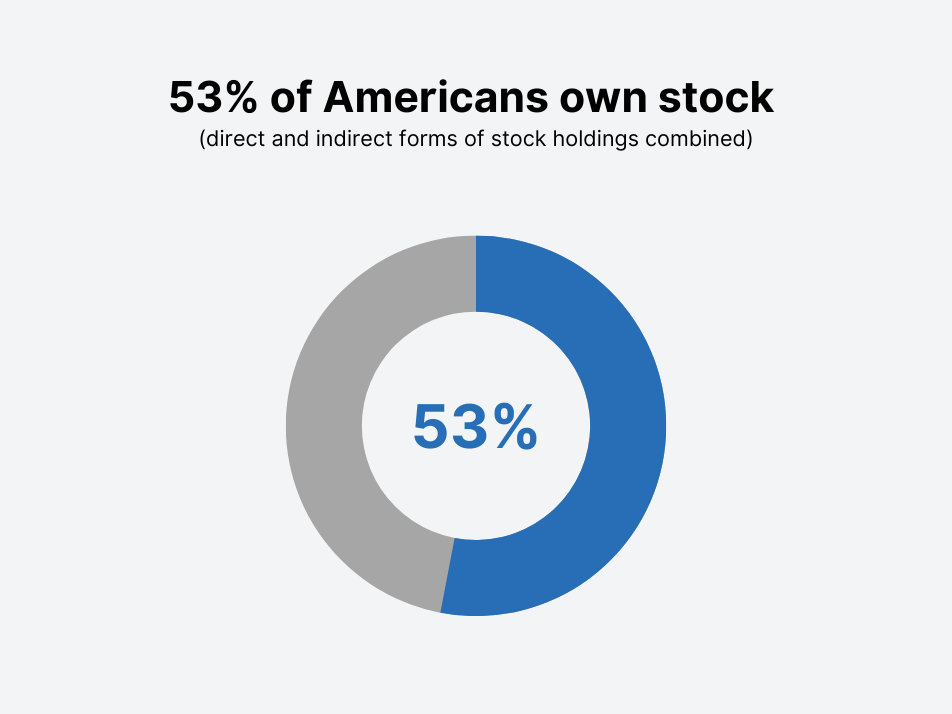
However, the number of American adults participating in the stock market has not increased from 2001, when 52.2% of survey respondents said they held stocks. The most common way for families to own stocks was through a tax-deferred retirement account, followed by direct holdings of stocks, direct holdings of pooled investment funds, and managed investment accounts.
Source: US Federal Reserve
2. Are more people investing in stocks?
It’s well known that retail investors pile in when the markets go up and get spooked when things go south. For example, Schwab, one of the largest US-based brokerage firms, saw a 41% decrease in new account openings in May 2022 compared to May 2021. Nordnet, the largest Scandinavian online brokerage, had a 67% drop in the same period. But over the longer term, are more people investing in stocks?
According to the US Federal Reserve, which produces the most accurate data on US stock ownership, the number of American adults with direct stock holdings, i.e. stocks not held in retirement accounts, has not increased in the past 20 years. On the contrary, fewer Americans own stocks outside now than they did in the early 2000s. In 2019, 15.20% of Americans owned stocks and 9.0% investment funds. In 2001, those numbers were 21.30% and 17.70%, respectively.
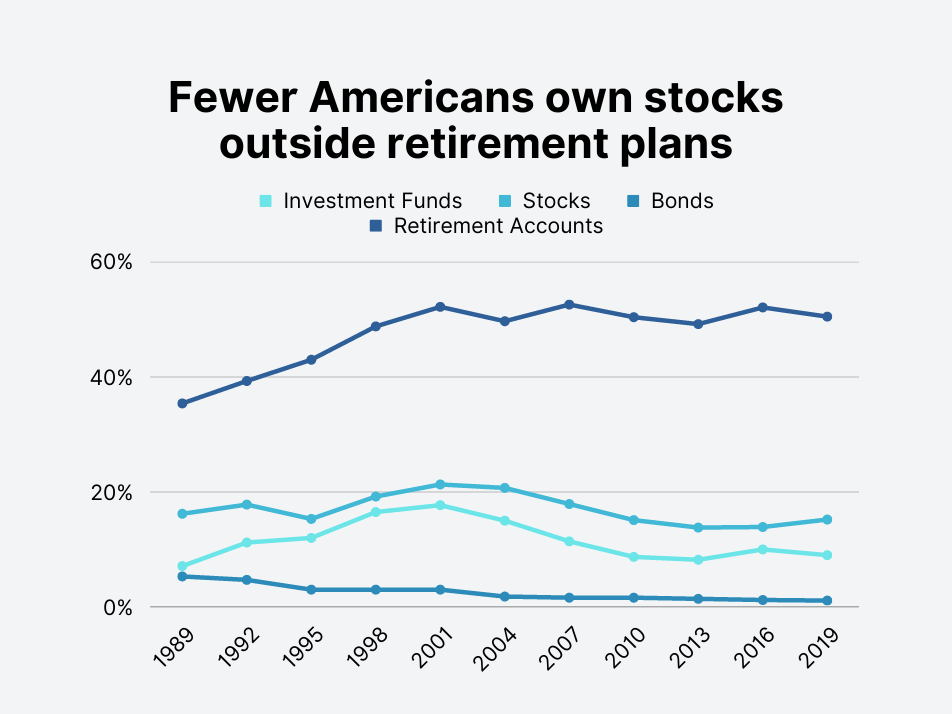
In Europe, the picture is similar. In Germany, there were 12.1 million retail investors in 2021, equal to 14.53% of the population. That’s down from 12.9 million people, or 15.6% of the population, in 2001. In the UK, many retail investors invest through the Individual Savings Accounts (ISA). The number of people subscribing to Stocks and Shares ISAs, which is the type of ISA that can hold investments, peaked in 2010 at 3,387 thousand but has declined to 2,727 thousand in 2020, a 19% decrease.
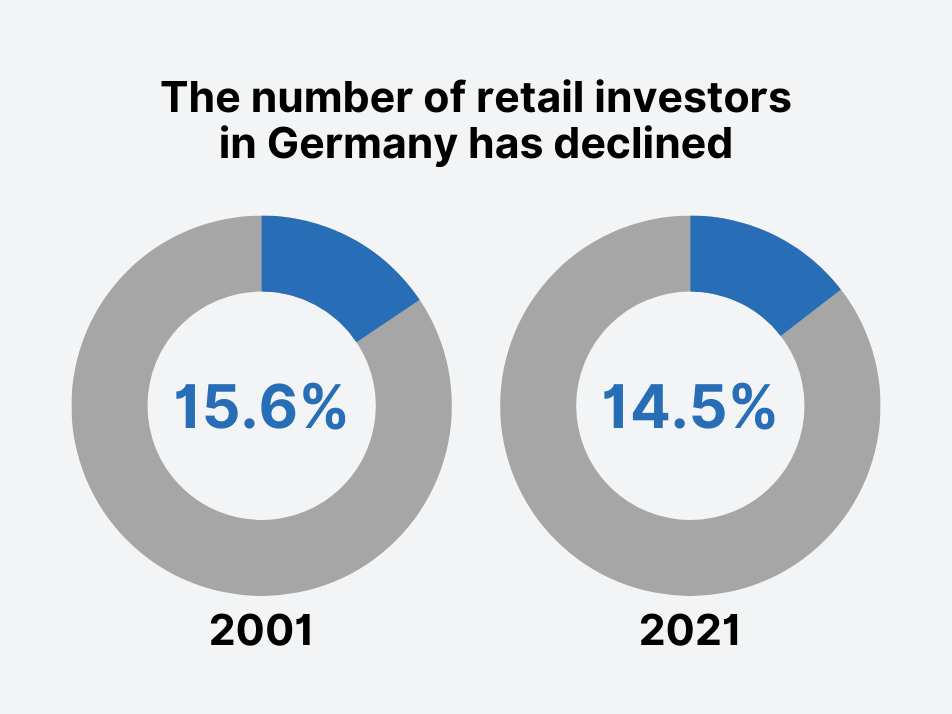
3. How many retail traders lose money?
A retail trader is an individual who frequently trades financial products for their own account or trade on a short-term basis for quick profits. They’re different from a retail investor, who is more focused on the long-term goal of saving.
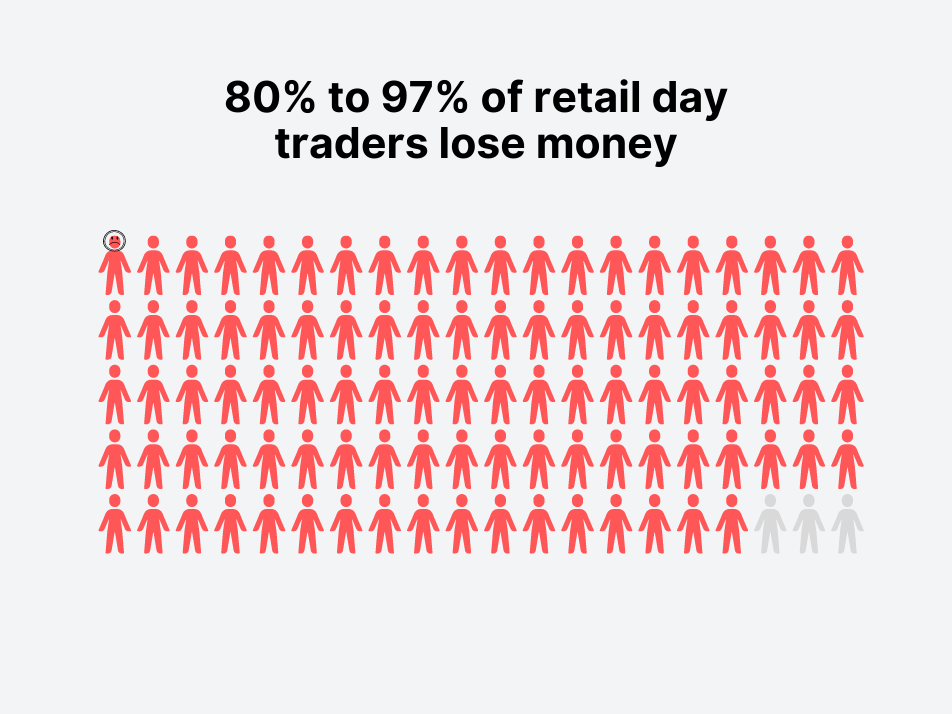
According to studies from around the world, 80% to 97% of retail traders lose money when attempting to actively trade stocks and other markets. In other words, only 3% to 20% of traders are successful. The conclusion is clear: the vast majority of people who try to make a quick buck by trading lose money.
Here are a few of the studies:
- According to a study by the Securities and Exchange Commission of forex traders, 70% of retail traders lose money on average every quarter, with most losing 100% of their money after 12 months.
- In Europe, the number is similarly bleak. A 2016 study by the UK Financial Conduct Authority (FCA) found that 80% of retail investors lost money when trading in CFDs over one year.
- France’s Autorité des Marchés Financiers (AMF) found that 89% of consumers lost money on these products. The Central Bank of Ireland (CBI) found that 75% of consumers lost money.
- A study of Brazilian futures traders discovered that 97% of those who traded in the market for more than 300 days lost money on their trades. In other words, only 3% of traders were profitable after one year.
- Individual day traders in Taiwan were studied over a 15-year period from 1992 to 2006. The results indicated that even the most experienced traders lose money, and many persist despite an extensive experience of losses. The researchers bluntly concluded, “trading to learn is no more rational or profitable than playing roulette to learn.”
Day trading is tempting, and we all like the idea of turning a small sum of money into a large one quickly. But the evidence is unambiguous: it’s mostly a fool’s game.
4. Which country likes to invest the most?
Hong Kong has the highest percentage of retail investors as a share of the population, with 57% of Hong Kong respondents in a 2020 survey saying they had invested in the stock market. This was followed by Singapore (53%) and the United States (52%).
Interestingly, the countries with the most retail investors are not the same as the most financially literate countries. According to Standard & Poor’s financial literacy survey, Denmark, Norway, Sweden, Canada, and Israel are the most financially literate countries, but they are not in the top three for retail investors. This suggests that financial literacy does not necessarily lead to more participation in the stock market.
Source: Finder, US Federal Reserve, S&P
5. Do men invest more than women?
In countries where data is available, men are more likely than women to be investors. According to the US Federal Reserve, 53% of American adults own stocks. Historically, 60% of US investors have been males, whereas only 40% of investors have been women. According to a 2022 Gallup survey, this 20 percentage point gap has shrunk to 4% in the period 2009 to 2017. Men, therefore, still make up the majority of investors, but the gender gap is narrowing.
In other parts of the world, men are also more likely to invest than women. In the UK, a 2021 study by AJ Bell found that 12% more men than women invest in stocks outside their pensions. In Australia, the Australian Securities Exchange (ASX) found that investors are predominantly male (58%), meaning that women make up 42% of investors. In Belgium, 65% of equity investors are men, compared to only 35% women.
Surprisingly, there doesn’t seem to be any direct correlation between how gender-equal a society is and how many women are investors. For example, in Denmark, considered one of the most gender-equal countries in the world, 4% more men than women invest in the stock market. In neighbouring Sweden, which shares the same high level of gender equality, 20% more men than women are investors.
6. Are women better investors than men?
Studies from different fields show that men are more willing to take risks than women. However, men’s taste for risk doesn’t necessarily translate into higher returns when it comes to investing. Wells Fargo looked at gender and investment performance and found that women, on average, are more risk-averse than men. This helped women achieve higher risk-adjusted returns than men.
A study by Fidelity in 2021 showed that women outperformed men by 0.4%. This was based on data from 5 million of the brokerage’s customers over a ten-year period. A 2001 study from researchers at Berkeley reached a similar conclusion. They discovered that men are more overconfident than women, and this overconfidence leads men to trade more and do around 1% worse than women per year.
7. Why don’t more people invest?
While there are guarantees in life like death and taxes, there is no guarantee that you will make money from investing. Many people are put off by this element of uncertainty. However, it’s not the only reason people don’t invest in financial assets. And as some food for thought, the majority of retirees who have investments actually regret not investing sooner.
A 2021 survey of American retail investors found that people don’t invest mainly because they feel they don’t have enough money. The second reason is a lack of knowledge and that they don’t understand stocks. More than half of Americans are actually putting money even if they don’t know it. The money is just invested in a retirement account like a 401(k) without the person realising it.
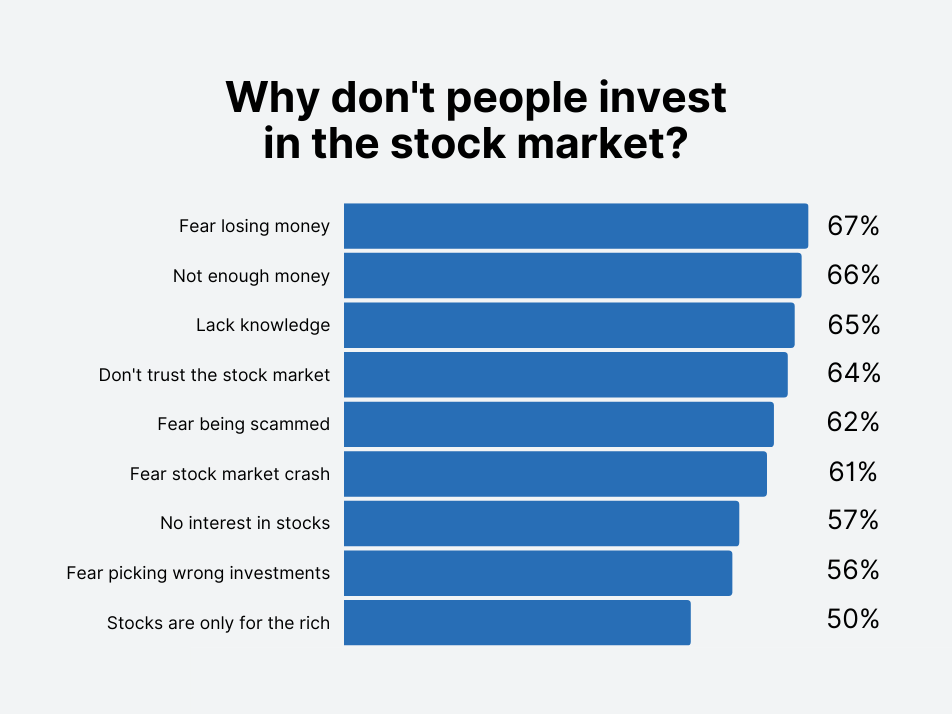
In Europe, a survey of non-investors by Deutsche Börse, the operator of the Frankfurt stock exchange, revealed similar results. 67% of respondents said that fear of high losses keeps them from investing. 66% said they didn’t have enough money to invest, and 65% said they didn’t know enough about investing.
8. How much money is invested in ETFs?
Investors worldwide had a total of €8.8 trillion (approx. $9.31 trillion) invested in exchange-traded funds (ETFs) worldwide in 2021, according to data from EFAMA. ETFs received a record-breaking €1,084 trillion (approx. $1.146,84 trillion) in inflows in 2021, which was about 69% higher than in 2020.
ETFs now represent 14.7% of the global fund market. This percentage has risen steadily from below 10% (9.8%) in 2017, as ETFs have become increasingly popular with global investors. The US remains the largest fund market in the world, with a 49% market share in 2021, followed by Europe (32%), Asia-Pacific (13%), and Central and South America (6%).
At the end of 2021, equity ETFs accounted for 78.5% of the worldwide ETF market. Bond ETFs accounted for 16.7%, while other types of ETFs made up 5% of the ETF market. Over the past five years, the proportion of equity ETFs has risen gradually, owing to generally increasing stock market prices.
9. How many people use and own Bitcoin?
We don’t know how many individuals own and use Bitcoin. We can get a sense of how popular Bitcoin is by looking at the number of addresses and active wallets. However, a single person can have multiple addresses and wallets, many people keep their Bitcoin on different exchanges, and some addresses have remained inactive for a very long time. In other words, it’s a black hole.
The best way to gauge Bitcoin ownership is through surveys. Different polls show that 16% to 22% of the US adult population owns Bitcoin. Numbers from the New York Digital Investment Group in 2021 found that about 22% own Bitcoin, Pew Research Center showed that around 16% of Americans own Bitcoin, and a study by Grayscale Investment suggested that the number is 26%.

In Europe, Bitcoin and cryptocurrency ownership vary significantly by country. In France, 8% of the population is estimated to own cryptocurrencies. In the Netherlands, 13% of people own cryptocurrencies, and in Germany, 10% of the population own cryptocurrencies.
10. How many people own gold?
Gold is as old as money itself. But the gold market is also very opaque. It’s difficult to estimate how many private investors actually own gold in the form of bullion (coins and bars). In many countries, like the US, there is no obligation to declare gold holdings. The World Gold Council, an international organisation promoting the gold industry, has refused to disclose data on private gold ownership to the public. Still, we can get a sense of global private gold ownership from surveys and research reports.
Around 10% of American adults own physical gold, according to a 2017 article in the Los Angeles Times and a 2020 poll. However, American gold ownership is dwarfed by other countries. In Germany, a whopping 38% of the population has gold coins or bars in their private possession. In fact, German households own 6.2% of the world’s total gold. That’s two and a half times more than the Bundesbank, Germany’s central bank.
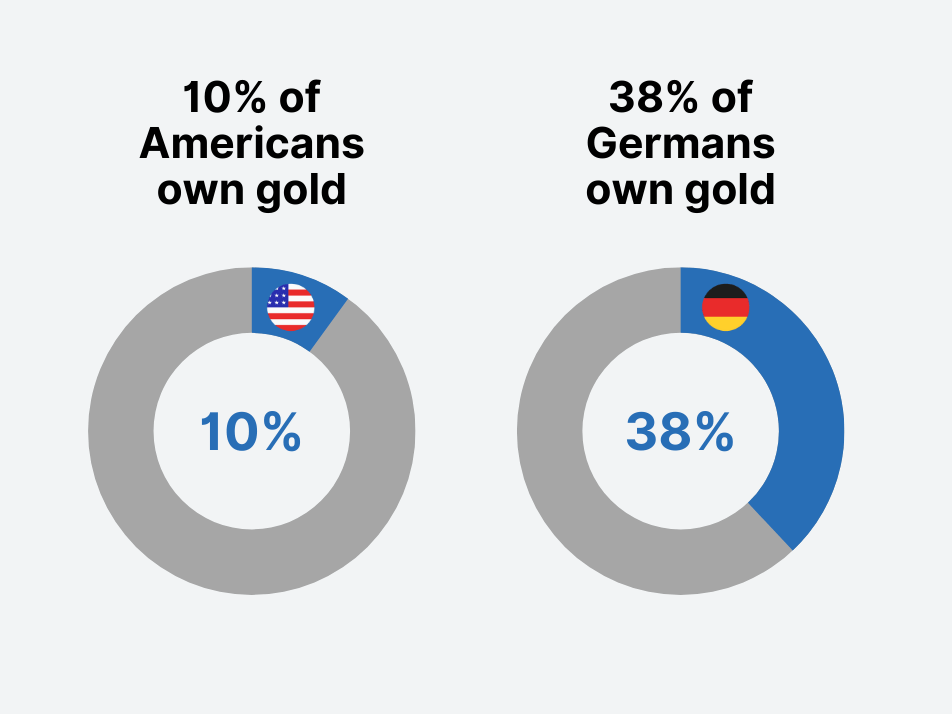
11. How many people think the stock market is rigged?
One reason why some people don’t invest could be because they think the stock market is stacked against them. The revelations of corruption and cooked books on Wall Street during and after the 2008-09 financial crisis led to a severe loss of trust in the stock market. More recently, the meme stock debacle in late 2020 and early 2021 has further eroded confidence that the markets are fair.
In the US, 48% of adults with and without investment experience think the stock market is rigged against the average investor. In Europe, 64% of German non-investors believe that the stock market is fixed. Interestingly, most Germans are also negative about capitalism in general, with only 16% expressing a positive view of it.
The stock market is not, technically speaking, rigged against the average investor as regulations and laws in the developed world have never been more strict. However, it’s clear that Wall Street’s major players have significant advantages over ordinary people, for example, through algorithmic trading robots, access to inside information, vast sums of capital and the ability to donate to and influence lawmakers.
12. How many people traded GameStop?
GameStop is a company that sells video games and gaming merchandise. In January 2021, a group of small investors who were members of the Reddit forum WallStreetBets began buying up shares of GameStop. The phenomenon soon spread to other platforms and online communities, and the mass media eventually picked up on it.
A study by the Harris Poll on behalf of Yahoo Finance found that over a quarter of Americans bought shares from at least one of more than twenty viral company stocks like GameStop in January 2021. In Europe, GameStop was also the most stock during the same month. The movement also spread to Asia, where retail investors in South Korea borrowed such an excessive amount of money that local brokerages had to cease offering leverage for GameStop and similar trades.
Conclusion
There you have it—the top 12 retail investor statistics you need to know.
The times are changing, and so is the way people invest their money. With more awareness of financial products and technologies and a greater willingness to take risks, retail investors are playing an increasingly important role in the global economy.
What do you think about these retail investor statistics? Are you surprised by any of them?
We were surprised that the number of investors has not changed much in the last two decades. It was also fascinating to read pensioners’ statements saying they wished they had invested earlier.



